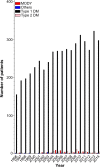Danish Registry of Childhood and Adolescent Diabetes
- PMID: 27822115
- PMCID: PMC5094642
- DOI: 10.2147/CLEP.S99469
Danish Registry of Childhood and Adolescent Diabetes
Abstract
Aim: The aims of the Danish Registry of Childhood and Adolescent Diabetes (DanDiabKids) are to monitor and improve the quality of care for children and adolescents with diabetes in Denmark and to follow the incidence and prevalence of diabetes.
Study population: The study population consists of all children diagnosed with diabetes before the age of 15 years since 1996. Since 2015, every child followed up at a pediatric center (<18 years of age) will be included.
Main variables: The variables in the registry are the quality indicators, demographic variables, associated conditions, diabetes classification, family history of diabetes, growth parameters, self-care, and treatment variables. The quality indicators are selected based on international consensus of measures of good clinical practice. The indicators are metabolic control as assessed by HbA1c, blood pressure, albuminuria, retinopathy, neuropathy, number of severe hypoglycemic events, and hospitalization with ketoacidosis.
Descriptive data: The number of children diagnosed with diabetes is increasing with ∼3% per year mainly for type 1 diabetes (ie, 296 new patients <15 years of age were diagnosed in 2014). The disease management has changed dramatically with more children treated intensively with multiple daily injections, insulin pumps, and increased number of self-monitored blood glucose values per day. These initiatives have resulted in a significant improvement in HbA1c over the years and a decrease in the number of children experiencing severe hypoglycemia, diabetic nephropathy, and retinopathy.
Conclusion: The systematic collection of data in DanDiabKids documents improved quality of care over the last 12 years, despite a substantial increase in the number of patients cared for by pediatric departments in Denmark, fulfilling the purpose of the registry.
Keywords: DanDiabkids; HbA1c; quality of care; severe hypoglycemia; treatment modalities.
Conflict of interest statement
JS has Novo Nordisk shares and is a member of Bayer and Novo Nordisk advisory board. PK has received salary in a Novo Nordisk-sponsored register study on growth hormone treatment. NTH has received fee/salary for lectures for Novo Nordisk, Medtronic, Sanofi-Aventis, and Pfizer. HBM has Novo Nordisk shares and is a member of Novo Nordisk and Boehringer Ingelheim advisory boards. CC, MM, LL, and JJ report no conflicts of interest in this work.
Figures



References
-
- Mortensen HB. Dansk register for børne- og ungdomsdiabetes med tilhørende biobank [Danish childhood diabetes registry combined with a biological bank] Ugeskr Laeg. 1996;158:358. Danish.
-
- Nordly S, Jørgensen T, Andreasen AH, Hermann N, Mortensen HB. Quality of diabetes management in children and adolescents in Denmark1. Diabet Med. 2003;20:568–574. - PubMed
-
- Nordly S, Mortensen HB, Andreasen AH, Hermann N, Jørgensen T. Factors associated with glycaemic outcome of childhood diabetes care in Denmark. Diabet Med. 2005;22:1566–1573. - PubMed
-
- Hanas R, Donaghue KC, Klingensmith G, Swift PGF. ISPAD clinical practice consensus guidelines 2009 compendium. Introduction. Pediatr Diabetes. 2009;10(suppl 12):1–2. - PubMed
-
- Svensson J, Lyngaae-Jørgensen A, Carstensen B, Simonsen LB, Mortensen HB, Danish Childhood Diabetes Registry Long-term trends in the incidence of type 1 diabetes in Denmark: the seasonal variation changes over time. Pediatr Diabetes. 2009;10:248–254. - PubMed
Publication types
LinkOut - more resources
Full Text Sources
Other Literature Sources

